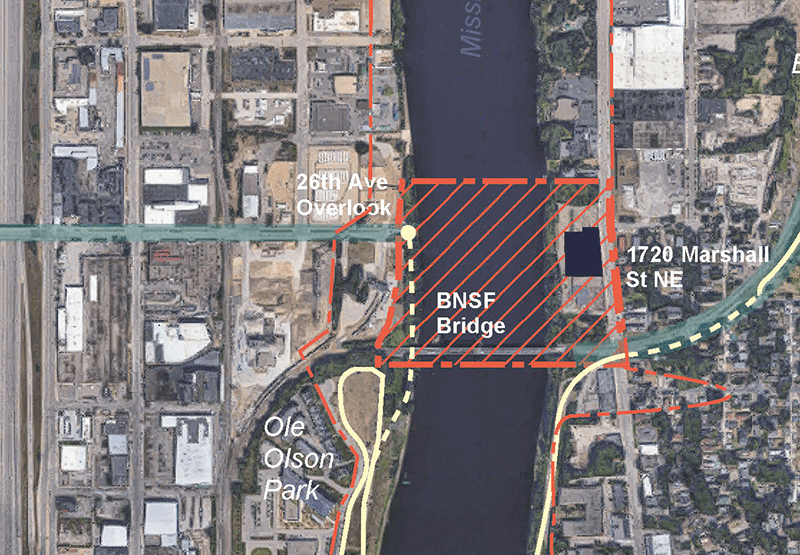The Minneapolis Park and Recreation Board (MPRB) has begun a feasibility study for a possible new bridge over the Mississippi River between North and Northeast Minneapolis for walkers and cyclists. The bridge would be the missing link in the Great Northern Greenway, connecting the Minneapolis Diagonal Trail to the river. The Greenway travels east-west from Theodore Wirth Regional Park to the river along 26th Avenue North, with the trail picking up in Northeast around 18th Avenue NE. MPRB commissioners approved a contract in September with a design team led by urban design and landscape architecture firm West 8 to assess the prospect of a new trail connection north of the existing BNSF railroad bridge.
Currently, the Lowry Avenue and Plymouth Avenue bridges are the only routes across the river north of Nicollet Island for bicycle and pedestrian traffic. Previous planning suggested a trail crossing be placed on the south half of the railroad bridge; the design team will look at the bridge’s age and whether a trail could be safely added next to an active freight line.
More recently, the concept of a new, stand-alone bridge was proposed. According to MPRB Project Manager Tyler Pederson, “The project has $300,000 to fund the feasibility study and initial project costs, as well as schematic design and updated project cost estimates.”
Pederson said the feasibility study will not produce concepts, but a set of “bridge typologies” and their costs, adding, “It’ll be a tool for the MPRB and its collaborators to decide on a cost range and bridge type to continue to develop. When a bridge typology is chosen, the design team will begin to produce concepts based on feedback from the public and other stakeholders. Those concepts will be evaluated, and a single concept will be developed in greater detail. That preferred concept will be considered next summer by the MPRB Board of Commissioners for adoption. The MPRB is evaluating funding sources now for the construction of the bridge.”
Several agencies will be involved in the project’s planning, permitting and funding. The MPRB plans to own the bridge and would likely oversee its construction. Pederson said “The MPRB is in the unique position to plan for and design a bridge over the Mississippi River that focuses solely on people, not vehicular transportation. People can connect free of traffic noise, smell and pollution. It can be a space that’s made for recreation, gathering and connecting.” He added that the project will require creative funding, including state bonding, local and regional grants and philanthropy.
The MPRB website notes, “As an MPRB-led initiative, this river crossing can be more aligned with the characteristics of a park, not just a transportation conduit. The bridge and its connective landscapes can be artful and fun but must also be obtainable and constructible.”
It would be the first new bridge over the Mississippi in Minneapolis since the I-35 Bridge which was completed in 1967 and replaced in 2008.
While the MPRB might consider the BNSF bridge as a possible part of the project, a query to Burlington Northern Santa Fe’s Public Affairs office got this reply: “Railroad tracks are private property designated for trains. The presence of pedestrians and cyclists on or near the tracks is not only illegal but also poses significant safety hazards. Safety is paramount when evaluating projects on the BNSF network. … New parallel bicycle, pedestrian, and multi-use trails are not permitted on BNSF property. “
MPRB’s online project page for the study includes a tentative project schedule, a PowerPoint presentation listing the design partners and involved neighborhood organizations and a “Visioning” survey for the public. The feasibility of the project was to be determined by the end of November or early December; no report available yet. If it’s a go, MPRB will begin drafting schematics.

Aerial view of the area on the Mississippi River being considered for a new bridge that will connect North and Northeast Minneapolis. (Provided)